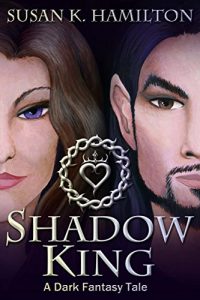Take a Little Off the Top: Seven Tips to Help You Self-Edit Your Novel Manuscript
 By Susan K. Hamilton
By Susan K. Hamilton
There’s no feeling quite like completing the first draft of your manuscript. There is an immense feeling of satisfaction, even of triumph. That giddiness, however, can quickly be subsumed by the dawning realization of what’s on the horizon: editing.
Editing can be a daunting prospect, but it is one hundred percent necessary for your manuscript to become the best it can be. Remember, however, that before you start to edit, you need to finish your rough draft.
Easier said than done: You’re going to be tempted to edit as you write. You will see words that aren’t exactly perfect. Sentences you know could be better. Dialogue that’s a bit awkward (okay, maybe a lot awkward). Words you spelled wrong.
Resist as best you can—your first draft is supposed to be messy and imperfect. I like to refer to my own as the “piñata draft.” It might look a little odd and all the parts might not fit together just the right way, but if I hit it long enough and hard enough with a big stick, something special will come out.
And the big stick I’m talking about is editing.
Once you’re ready to edit, here are a few things to think about (in no particular order):
1. Take a short hiatus. After you finish your first draft, put it away. Preferably for at least two weeks, but three is better. You need to give yourself a little distance. Then when you finally do start to edit, you’ll see everything with fresher eyes.
2. Use a different format or font. If you do a lot of your work on the computer, print your manuscript out and edit the paper version. And get yourself a red pen so you can see your edits. Another trick you can try is to switch to a different font. For example, if you wrote it in Times New Roman, switch the whole thing to Courier. Just that visual difference will make you approach the manuscript differently.
3. In beta readers we trust. Line up a couple trusted friends to read the manuscript, and give them permission to really tear into it. It might be hard for them to do at first, so insist. It also may be hard for you to hear the critiques they give you because this manuscript is your baby. But when they do, be objective—give ample consideration to what they say. The questions they have will likely be the same questions that other readers have. Use the perspective of your beta readers to your advantage.
4. Don’t try to edit everything at once. There are several aspects to editing a manuscript. Bigger picture development areas like pace, plotting, story arc, and character development are usually the first line of attack. Then line edits: making sure word usage is correct, checking facts and unknown words, syntax and clarity. Finally there is proofreading: checking that all the words are spelled correctly and punctuation is spot on. If you try to do all of them at the same time you’ll end up not only getting frustrated, but missing things as well. (Still a little puzzled by the different types of editing? Check out this nice summation from DartFrog.)
5. Punt passive voice. Do a search for every time you use “was” and “were”. In some cases they are the correct word to use, but doing this type of search gives you an opportunity to replace them, wherever possible, with a much stronger, active verb that helps make your writing pop more.
6. Read it out loud. This is a great tip that I don’t do often enough. Reading out loud will help you find places where your words might not flow as smoothly as you think they do. This is especially helpful when it comes to dialogue. Remember that written syntax is different than verbal syntax and by reading out loud you’ll hear where your dialogue is stiff.
7. Have no mercy: edit ruthlessly. Every scene and every character should do something that moves your story forward. Otherwise, get rid of it.
An editor told me that one of my characters in Shadow King—a character I was quite fond of—was a distraction and took away from the main story. She said it would be completely plausible if one of the other characters just absorbed the role this minor character played. It wasn’t feedback I enjoyed getting, because I had a real soft spot for this particular character—but the editor was right. I deleted the character, did some rewriting, and the story was stronger for it.
This same principle goes for words as well—if there are excess words that are just cluttering your pages, lose them. Look for words you use out of habit. Two of my favorites are “just” and “almost”. I guarantee that in most cases, you don’t need them. Also, use adverbs sparingly, not as a crutch.
Killing your darlings is really hard. Do it anyway and do it ruthlessly.
Editing isn’t a “one and done” process. Editing your first draft is just the beginning. Once you take care of all the rewriting that comes from editing your first draft, you’ll do it all over again. And again. I actually did at least eight rounds of edits and rewrites for Shadow King.
Eventually, however, you need to stop. Editing can become a never-ending cycle if you let it: there will always be something you want to change in a manuscript. My rule of thumb is that when I get to the point where all I’m doing is word-smithing the small stuff (“Should I use shrilled in this sentence or screeched?”) then it is time to be done.
And one last bit of advice: if you read older work, you’re going to find something you wish you’d changed or written differently. Don’t sweat it. Each story you write and edit will teach you something—everything you learned from the last manuscript will help make the next one even better.
So, grab your red pen and let’s get ruthless
.—
About the Author
Susan K. Hamilton is the award-winning author of epic, dark, and urban fantasy books including Shadow King, Darkstar Rising, and the forthcoming The Devil Inside. She’s also dipped her toe in the short fiction pond and has short stories included in the ESCAPE! Anthology and the upcoming DECEPTION! Anthology from Writing Bloc.
Horse-crazy since she was a little girl, she also loves comfy jeans, pizza, great stand-up comedy, and pretty much every furry creature on the planet (except spiders). Susan lives near Boston with her husband and a cat that runs the house like a boss.
SHADOW KING, Susan K. Hamilton
Ambition. Betrayal. Revenge.
 Centuries ago, the Faerie Realm was decimated by a vile and corrupt spell. To survive, the different faerie races—led by the Fae—escaped to the Human Realm where they’ve lived ever since.
Centuries ago, the Faerie Realm was decimated by a vile and corrupt spell. To survive, the different faerie races—led by the Fae—escaped to the Human Realm where they’ve lived ever since.
As the Fae Patriarch of Boston’s criminal underworld, Aohdan Collins enjoys his playboy lifestyle while he works from the shadows to expand his growing empire, until one night when he shares a shot of whiskey with the lovely Seireadan Moore…
A Fae Seer, Seireadan is haunted by a vision of the Fae responsible for destroying Faerie and murdering her family. Common sense tells her to stay away from Aohdan, but his magnetism and charm are irresistible.As their passionate affair intensifies, Seireadan is pulled into the center of the underworld. And while her heart is bound to Aohdan, she cannot let go of her lifelong quest to hunt down the Fae who haunts her visions… especially when she realizes Aohdan might be the key to helping her find him.
But is revenge worth betraying the one she loves?
”An impressively crafted and inherently riveting read by a fantasy author with an exceptional gift for originality, character development, and the narrative storytelling arts. Susan Hamilton’s Shadow King will prove to be a welcome and popular addition to community library Fantasy Fiction collections.”
MIDWEST BOOK REVIEW
“From fantasy to thriller and intrigue to steamy romance, “Shadow King” weaves in and out of multiple genres making at appealing read for a wide spectrum of fans. With a plot that holds the reader hostage until the very end and fascinating characters, I couldn’t get enough of this story and look forward to reading more works from Susan K. Hamilton.”
S. HOYTE
Reviewer at ReaderViews
“Shadow King is a dramatic, thrilling, and exciting novel that will keep readers entertained, captivated, and engrossed from the very first page. “Aimee
Red Headed Book Lover Blog
BUY THE BOOK HERE
Category: How To and Tips































Comments (1)
Trackback URL | Comments RSS Feed
Sites That Link to this Post